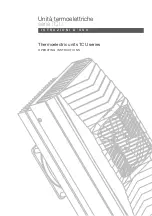
113
28. Auto Registration Troubleshooting
Chapter 28 - Auto Registration Troubleshooting
Overview
The RA-4 projection television chassis was the first to introduce a new registration system for converging the
red, green and blue colors of each CRT. The number of course adjustments were substantially reduced. SUB,
MID, BOW and 4
th
-family wave adjustments were eliminated. The number of adjustments was reduced to CENT,
SKEW, SIZE, LIN, KEY and PIN. MLIN was added to the RA-5A and RA-6 chassis. Once these coarse adjustments
are completed, fine adjustments can be performed by pressing the “9” key on the remote and a cursor appears
on the screen. Color selection is accomplished by pressing the “3” key. The cursor can be moved around the
screen by using the “1” and “4” keys or by pressing the joystick down to turn the cursor white. In this state, the
cursor can be moved any direction with the joystick or position buttons of the remote. Pressing the joystick again
will change the cursor to the selected color, allowing vertical and horizontal shifting of the selected color at the
cursor position.
Another outstanding feature of this new design was the placement of light sensors behind the front bezel and
outside the screen area. This feature allows the customer to press a button and re-converge the set should it
drift out of adjustment. It was originally labeled “auto focus” and was subsequently named “Flash Focus
TM
”. The
position of each color is memorized by the sensors by reading the offset position, which is performed in the
service mode.
The RA-4 chassis utilized eight sensors; one on each corner and one at the center of the top, bottom, right and
left sides. Later models only use four sensors located at the center of each side of the screen. Since most
drifting of convergence occurs vertically or horizontally across the screen, the four sensors work adequately to
provide size, centering and skew control.
The RA-4 series housed all of the convergence circuitry (except for the drivers) in a separate plug-in module
known as the BD board. In the RA-5A and RA-6 chassis, it is labeled as the AD board. In the RA-3 series, the
circuits reside on the A board.
Convergence is adjusted by entering the service mode and selecting the “PJED” group with the “2” or “5” keys.
PJED stands for “Projection Engine Digital”. The lettering at the top of the screen will change from green to
white. Graphics for convergence alignment are generated as RGB signals by the convergence CPU and sent to
the video process IC. Once you are in the PJED mode, between 41 and 86 adjustments are displayed depending
on the chassis. Scrolling through the data settings is accomplished with the “1” and “4” keys of the remote and
settings are changed with the cursor.
Most of the data settings are not adjusted as part of the convergence alignment. About 50% of the values should
be left with factory default settings and the remainder will have varying settings based on the stored offset values
for the sensors. Only the last seven or eight adjustments are used for alignment.
The purpose of this chapter is to provide some tips on successful alignment procedures and what to do if an error
displays when the Flash Focus
TM
is engaged. With the proper knowledge, very accurate convergence and
geometry can be performed which rivals that of a direct-view television.
Convergence Tips
Following The Correct Procedures
: Proper alignment of the coarse convergence is extremely important for a
successful outcome. This is particularly true of the height and centering. If they are not properly aligned, the
edges (and especially the corners) will develop increased distortions and will require extensive use of the fine
adjustment cursor to correct. Severe corner distortions may not adjust correctly because the cursor data reaches
its maximum value. The use of an external video source denoting the edges of the raster is recommended to
obtain proper size, linearity and centering. If these steps are followed, only minor touchups will be necessary
with the fine cursor.
NOTE: Do not use the internally generated crosshatch or dots for centering. The position of this graphic is
adjustable independent of the true centering. Most internal patterns are not centered since they are loaded with
default data and are not used by the factory for alignment purposes. Once proper center has been achieved or









































